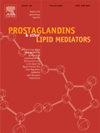GLP-1RAs regulate lipid metabolism and induce autophagy through AMPK/SIRT1 pathway to improve NAFLD
IF 2.5
3区 生物学
Q3 BIOCHEMISTRY & MOLECULAR BIOLOGY
Prostaglandins & other lipid mediators
Pub Date : 2025-04-01
DOI:10.1016/j.prostaglandins.2025.106987
引用次数: 0
Abstract
Background
Non-alcoholic fatty liver disease (NAFLD) is a leading cause of cirrhosis and a major risk factor for hepatocellular carcinoma and liver-related death. Diabetes medications have been studied as potential treatments for NAFLD. Glucagon-like peptide-1 agonists (GLP-1RAs) have been rarely reported in the treatment of NAFLD alone as an anti-diabetic drug, and its specific mechanism of action is unknown. We investigated whether the therapeutic effect of liraglutide (LRG, a representative drug of GLP-1RAs) on hepatic steatosis is related to regulating lipid metabolism and enhancing autophagy in the hepatocytes.
Methods
We examined the effect of LRG on fat accumulation in fatty hepatocytes, and discussed its effects on enzymes related to lipid metabolism and autophagy. Meanwhile, knockdown of SIRT1 in free fatty acids(FFA)-treated cells was used to detected the influence of LRG on lipid metabolism and autophagy by regulating of AMPK/SIRT1 signaling.
Results
Our findings showed that free fatty acids (FFA) induced hepatocyte steatosis, which was significantly reversed by LRG. Meanwhile, LRG significantly regulated the expression of hepatocyte lipogenesis and cytosolic lipolysis-related proteins (FAS, ACC1, ATGL, HSL, LAL). Furthermore, LRG enhanced FFA-induced suppression of autophagy and SIRT1 expression, reducing intracellular lipid accumulation. It is evident that LRG regulates lipid metabolism and induces autophagy in an (AMPK)-dependent manner. Moreover, SIRT1 knockdown inhibited the autophagy-inducing and lipid-lowering effects of LRG.
Conclusion
GLP-1RAs may lower hepatic steatosis by regulating lipid metabolism and enhancing autophagy in an AMPK/SIRT1-dependent manner, providing a new target for the treatment of NAFLD.

GLP-1RAs通过AMPK/SIRT1通路调节脂质代谢,诱导自噬,改善NAFLD
背景:非酒精性脂肪性肝病(NAFLD)是肝硬化的主要原因,也是肝细胞癌和肝脏相关死亡的主要危险因素。糖尿病药物已被研究作为NAFLD的潜在治疗方法。胰高血糖素样肽-1激动剂(Glucagon-like peptide-1 agonists, GLP-1RAs)作为一种抗糖尿病药物单独用于NAFLD治疗的报道很少,其具体作用机制尚不清楚。我们研究GLP-1RAs的代表药物利拉鲁肽(LRG)对肝脂肪变性的治疗作用是否与调节肝细胞脂质代谢、增强肝细胞自噬有关。方法观察LRG对脂肪肝细胞脂肪堆积的影响,并探讨其对脂质代谢和自噬相关酶的影响。同时,通过敲低游离脂肪酸(FFA)处理细胞的SIRT1,检测LRG通过调节AMPK/SIRT1信号通路对脂质代谢和自噬的影响。结果游离脂肪酸(FFA)诱导肝细胞脂肪变性,LRG可显著逆转这一过程。同时,LRG显著调节肝细胞脂生成和胞质脂解相关蛋白(FAS、ACC1、ATGL、HSL、LAL)的表达。此外,LRG增强ffa诱导的自噬抑制和SIRT1表达,减少细胞内脂质积累。很明显,LRG以(AMPK)依赖的方式调节脂质代谢并诱导自噬。此外,SIRT1敲低抑制了LRG诱导自噬和降脂作用。结论lp - 1ras可能通过AMPK/ sirt1依赖性调节脂质代谢和增强自噬来降低肝脏脂肪变性,为NAFLD的治疗提供了新的靶点。
本文章由计算机程序翻译,如有差异,请以英文原文为准。
求助全文
约1分钟内获得全文
求助全文
来源期刊

Prostaglandins & other lipid mediators
生物-生化与分子生物学
CiteScore
5.80
自引率
3.40%
发文量
49
审稿时长
2 months
期刊介绍:
Prostaglandins & Other Lipid Mediators is the original and foremost journal dealing with prostaglandins and related lipid mediator substances. It includes basic and clinical studies related to the pharmacology, physiology, pathology and biochemistry of lipid mediators.
Prostaglandins & Other Lipid Mediators invites reports of original research, mini-reviews, reviews, and methods articles in the basic and clinical aspects of all areas of lipid mediator research: cell biology, developmental biology, genetics, molecular biology, chemistry, biochemistry, physiology, pharmacology, endocrinology, biology, the medical sciences, and epidemiology.
Prostaglandins & Other Lipid Mediators also accepts proposals for special issue topics. The Editors will make every effort to advise authors of the decision on the submitted manuscript within 3-4 weeks of receipt.
 求助内容:
求助内容: 应助结果提醒方式:
应助结果提醒方式:


